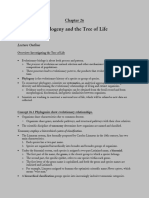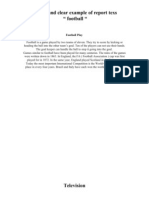(A) Explain The Relationship Between Classification and Phylogeny
(A) Explain The Relationship Between Classification and Phylogeny
Uploaded by
Misha PatelCopyright:
Available Formats
(A) Explain The Relationship Between Classification and Phylogeny
(A) Explain The Relationship Between Classification and Phylogeny
Uploaded by
Misha PatelOriginal Title
Copyright
Available Formats
Share this document
Did you find this document useful?
Is this content inappropriate?
Copyright:
Available Formats
(A) Explain The Relationship Between Classification and Phylogeny
(A) Explain The Relationship Between Classification and Phylogeny
Uploaded by
Misha PatelCopyright:
Available Formats
2009 EVOLn.
2 SUMMARY
(a) Explain the relationship between classification and phylogeny. 1. Classification = Binomial system (Linnaeus) Naming & grouping organisms into meaning sets or divisions on basis of their common characteristics Binomial system.. Study of diversity of organisms with the goal of determining the phylogeny or evolutionary history or a group of organisms stresses common ancestry and degree of structural differences among divergent groups
2. Phylogeny
3.
CLADISTICS arranges taxa in a type of phylogenetic tree called cladogram use of shared derived characteristics to classify organisms primitive character) = one that is present in the common ancestor and all members of a group derived character = one that is found only in a particular line of descent B C Descendents Unique ancestor to C Common ancestor to B & C Shared history to B & C Speciation event
RECEN T
PAST
Characters used in cladistics can include morphology, physiology, behaviour and DNA Clade = grouping that includes a common ancestor and all its descendents In contrast, a paraphyletic group consists of an ancestral species and some but not all its descendants A polyphyletic group includes taxa with different ancestors. Cladists are guided by the principle of parsimony
2009 EVOLn. 2 SUMMARY
the minimum number of assumptions is the most logical
(b) Explain how homology (ANATOMY; EMBROLOGY; MOLECULAR) support Darwins theory. Homology refers to fundamental similarity in characteristics that occurs due to descent from a shared ancestry. o These characters are altered in its decedents over time as they face different environmental conditions. Analogy (homoplasy). Analogous structures may have similar functions but are based on vastly different structures that are not derived from a common ancestor. E.g. fins of fish & dolphin o These characters are altered in its decedents over time as they face similar environmental conditions. 1. Vertebrate forelimb / pentadactyl limb Evolutionarily related species may possess homologous structures that have been modified in ways that allow them to be used differently by each species. In some cases, such structures are no longer needed and degenerated to non-functional vestigial structures. (humerus) is attached to (ulna & radius), several small carpals, metacarpals, attached to five digits Modified to flippers in dolphins; wings in bats, digging in moles, grasping in primates Organisms having vestigial structures share a common ancestry with organisms in which the structure is functional. When selection forces that keep the structure in functional condition is no longer present, the structure may degenerate over many generations. The more closely related organisms are, the longer the embryological development remains similar Pharyngeal gill slits link phylogeny of humans to fishes; post anal tail link man to fish reptiles birds Notochord retained as vertebral discs link humans to chordates At the molecular level, certain characteristics are found in all living cells, suggesting all living species are derived from a common ancestor. All living species use DNA to store information. RNA molecules are used to access that information.
2.
EMBRYOLOGY
3.
MOLECULAR
2009 EVOLn. 2 SUMMARY
Proteins are the functional products of most genes.
All species that use oxygen have similar proteins that together make up an electron transport chain and an ATP synthase. Nearly all organisms can metabolise glucose via the glycolytic pathway. In addition, species that are closely related tend to have DNA or RNA sequences, amino acid sequences that are more similar to each other than to those distantly related. E.g. p53 protein that plays a role in preventing cancer. E.g. amino acid sequence in beta haemoglobin protein, cytochrome c
(c) How do biogeography & the Fossil record support evolutionary deduction based on homology Biogeography is the study of the geographical distribution of extinct and modern species. Biogeography shows that unique species found on islands and other remote areas have arisen because the species in these locations have evolved in isolation from the rest of the world. 1. ISLAND BIOGEOGRAPHY e.g. Darwins finches 2. Ancestor = mainland ground finch On the Galapagos, finches diversified in absent of other bird species no competition form other forms. [ref to Evoln. 1 summary] Adapted to diverse niches available Mainland these habitats occupied by different species birds present Marsupials found in Australia, south America Australia Arose before placentals Diversified and adapted to all niches because of lack of competition by placentals Australia separated by ocean from other continents where placentals were found due to continental drift. To an astonishing degree, Australian marsupials resemble placental mammals living in other continents. They are the result of convergent evolution - similar forms from different ancestry having evolved in different isolated areas because of similar selective pressures in similar environments
CONTINENT BIOGEOGRAPHY e.g. Australian marsupials
Convergent evolution
3.
CONTINENT DRIFT
2009 EVOLn. 2 SUMMARY
The drifting apart of landmasses splits up organisms by the development of oceanic barriers, isolating descendent populations, which then evolve to form new taxa. (This is an example of allopatric speciation. Ref. to Evolution Pt.1)
4.
FOSSIL RECORD
Fossils are relics or impressions of extinct organisms preserved in rock. Are highly suggestive of evolution from common descent as they show: older forms are simpler than newer forms; The number of species increases with time
o
HORSES The earliest form of the horse were small (the size of dogs), with short legs and broad feet. Had low crown teeth Features adapted to wooded habitats, browsing on leaves and herbs and escaping predators by dodging through the forest vegetation. Modern horses evolved to open grasslands. Increased in size, toe reduction and high crown tooth. He increase in size and changes in foot structure allowed horses to escape predators and travel great distances in search of food. Changes in horse teeth are consistent with a shift in diet from tender leaves to grasses that need more chewing. Archaeopteryx intermediate between dinosaurs and birds Jaws with teeth, long bony tail, gait link it to carnivorous dinosaurs wings with feathers link it to birds
Transitional Fossils link older fossils to modern species
(d) Advantages of molecular (nucleotide; aa sequences) methods in classification 1.All known life is based on nuclei acids thus studies involving any types of taxa can use DNA sequence data. 2. 3. They can be used to compare species so phylogenetically distant that they share very few morphological similarities. They are objective and quantitative. Molecular character states are unambiguous (e.g. A, C, G and T) 4. May be used to measure degree of relatedness quantitatively Amino acid sequences for many proteins and nucleotide sequences for a rapidly increasing number of genomes can be accessed from large electronic databases and used for comparative study and classification.
2009 EVOLn. 2 SUMMARY
5.
Offers an enormous set of characters to be studied. Each nucleotide position can be considered a character and each organism has millions to billions of nucleotide positions. Molecular data are easily converted to numerical form and hence are amenable to mathematical and statistical analysis. avoid pitfalls of convergent evolution.
6. 7.
(e) Explain how recessive alleles may be preserved in a natural population 1. Diploidy 2. Recessive alleles which are less favourable are propagated in hetrozygote condition Presence of plasmodium causes rbc to rupture stopping life cycle Cystic fibrosis malfunction of Cl- transport protein lungs, digestive system; maintain water equilibrium in cells 3. Higher survival to diarrhoea Inbreeding When relatives mate higher chance of homozygosity of recessive alleles
Heterozygote advantage e.g. sickle cell
(f) Describe the neutral theory of molecular evolution 1. MOLECULAR CLOCK neutral mutations occur at a relatively constant rate thus they can act as a molecular clock gene sequences of the species accumulate independent mutations after they have diverged from each other; a longer period after divergence allows for a greater accumulation of mutations. Because the relationship between Nucleotide differences in homologous genes between pairs of species and time is linear we can predict when a pair of species have diverged from each other
2.
NEUTRAL THEORY
Kimuras neutral theory of evolution states that most genetic variation (in a population) is due to the accumulation of neutral mutations (at the molecular level). These mutations have attained high frequencies in a population via genetic drift. Neutral mutations involve changes in genotypes that do not affect the phenotype of the organism. nucleotide substitutions are more prevalent in the third base than in the first or second base. Mutations in the third base are often neutral because they do not change the amino acid coded for. In contrast mutations at the first or second base are more likely to be harmful than beneficial and tend to be eliminated from a population.
2009 EVOLn. 2 SUMMARY
When mutations do change the coding sequence, they are more likely to involve conservative substitutions. E.g., the difference between two alleles of a given gene may be the replacement of a nonpolar amino acid with another nonpolar amino acid. This change is less likely to affect protein function. Favourable mutations are rare, and detrimental mutations are likely to be eliminated from a population by natural selection.
Darwin vs. Neutral theory Darwin: Genetic variation in a population is the result of natural selection. Natural selection selects for the fittest phenotypes thus beneficial alleles get established in the population. Neutral theory: Genetic variation in a population is due the accumulation of neutral mutations. These mutations get established in the population by genetic drift. Kimura agreed with Darwin that natural selection is responsible for adaptive changes in a species during evolution.
You might also like
- Masgutova Neurosensorimotor Integration MethodDocument14 pagesMasgutova Neurosensorimotor Integration Methodristeacristi100% (2)
- Metabolic Response To TraumaDocument42 pagesMetabolic Response To Traumafunmilayo alagbe100% (3)
- Bms Professional Exams. Haematology - Mcqs Choose The Best Answer From A - EDocument10 pagesBms Professional Exams. Haematology - Mcqs Choose The Best Answer From A - ESAMMY83% (6)
- Embryology Exam - I PDFDocument8 pagesEmbryology Exam - I PDFuprince100100% (2)
- Evolution and Origin of BiodiversityDocument13 pagesEvolution and Origin of Biodiversitykharry8davidNo ratings yet
- EVOLUTIONDocument38 pagesEVOLUTIONFrancine Althea SimundacNo ratings yet
- The Theory of EvolutionDocument21 pagesThe Theory of EvolutionRose Anne GalanoteNo ratings yet
- Evidences of EvolutionDocument5 pagesEvidences of EvolutionAnthony CreationNo ratings yet
- Module 1 Angiosperm II RtmnuDocument19 pagesModule 1 Angiosperm II Rtmnuleninmd13No ratings yet
- Notes On Micro and Macro EvolutionDocument5 pagesNotes On Micro and Macro EvolutionObaiah JamakalaNo ratings yet
- Discuss Five Evidence That Support Organic EvolutionDocument4 pagesDiscuss Five Evidence That Support Organic EvolutionmuxyokadanNo ratings yet
- Natural Selection & EvolutionDocument9 pagesNatural Selection & EvolutionDaniel BerryNo ratings yet
- Heredity and Evolution NotesDocument5 pagesHeredity and Evolution NotesCapt Pradeep kumarNo ratings yet
- What Are Species?Document10 pagesWhat Are Species?homamunfatNo ratings yet
- Mod 6 Evolution and ClassificationDocument7 pagesMod 6 Evolution and ClassificationrasingtanyaroseNo ratings yet
- The Origin of Species: What Is A Species?Document6 pagesThe Origin of Species: What Is A Species?homamunfatNo ratings yet
- VariationDocument33 pagesVariationdejla67No ratings yet
- Biology Topic 5_ Evolution and Biodiversity check.docxDocument45 pagesBiology Topic 5_ Evolution and Biodiversity check.docx이호승No ratings yet
- Three Bones in The Jaw of Fish Are Homologous With Three Small Bones in The Inner Ear of MammalsDocument7 pagesThree Bones in The Jaw of Fish Are Homologous With Three Small Bones in The Inner Ear of Mammalsvivianzaq314No ratings yet
- Topic 5Document8 pagesTopic 5Antonio López JiménezNo ratings yet
- Descent With ModificationDocument38 pagesDescent With ModificationRhea Gulay100% (3)
- 4-5-2021 DarwinDocument4 pages4-5-2021 DarwinHaris KhanNo ratings yet
- Spooting 2024.doc 20240516 201549 0000Document9 pagesSpooting 2024.doc 20240516 201549 0000powfieeeNo ratings yet
- Evolution Study Guide2014 ANSWER KEYDocument3 pagesEvolution Study Guide2014 ANSWER KEYLisa LeviNo ratings yet
- 10.3 Gene Pools and SpeciationstudentnotesDocument4 pages10.3 Gene Pools and SpeciationstudentnotesMoahmed Mahmoud IB15A 363KAGYNo ratings yet
- Heredity and EvolutionDocument8 pagesHeredity and EvolutionAtharv ChhabraNo ratings yet
- Chromosomal MutationsDocument3 pagesChromosomal MutationsGladz GladzNo ratings yet
- EvolutionDocument5 pagesEvolutionsprcll.coc.12No ratings yet
- General Biology 2 NotesDocument97 pagesGeneral Biology 2 NotesMacky NohayNo ratings yet
- Biology Notes - Blueprint of LifeDocument31 pagesBiology Notes - Blueprint of Lifecody jamesNo ratings yet
- Evidences and Bases of EvolutionDocument21 pagesEvidences and Bases of EvolutionArlynKaren VargasNo ratings yet
- Adaptive Genetic Variation and Human Evolutionary PsychologyDocument17 pagesAdaptive Genetic Variation and Human Evolutionary PsychologypecaleproNo ratings yet
- 03 Pekan 2 - Genetika Populasi Dan Evolusi GenetikDocument31 pages03 Pekan 2 - Genetika Populasi Dan Evolusi GenetikEren YooNo ratings yet
- Chapter 26 Study GuideDocument4 pagesChapter 26 Study GuideBen ReebsNo ratings yet
- 5.1 Evidence For EvolutionDocument7 pages5.1 Evidence For EvolutionvaishnaviNo ratings yet
- CH 24 Guided ReadingDocument3 pagesCH 24 Guided ReadingSimranjit MangatNo ratings yet
- Bio 26Document8 pagesBio 26tqqzyqvhk4No ratings yet
- Speciation: Geographic Isolation Via Dispersal and ColonizationDocument9 pagesSpeciation: Geographic Isolation Via Dispersal and ColonizationNbisht25No ratings yet
- Reviewer in General BiologyDocument6 pagesReviewer in General BiologyArlynKaren VargasNo ratings yet
- Evidence of EvolutionDocument40 pagesEvidence of EvolutionMarco ZoletaNo ratings yet
- Overview: That "Mystery of Mysteries"Document3 pagesOverview: That "Mystery of Mysteries"eliboningerNo ratings yet
- Allopatric Species ConceptDocument8 pagesAllopatric Species ConcepttyssaNo ratings yet
- Week 4 - EVIDENCE OF EVOLUTIONDocument5 pagesWeek 4 - EVIDENCE OF EVOLUTIONVon DePedroNo ratings yet
- Chapter #2 The Tree of LifeDocument19 pagesChapter #2 The Tree of Lifengmmjjy4c5No ratings yet
- EvolutionDocument28 pagesEvolutionBongeka LangaNo ratings yet
- Chapter 20 Phylogeny (AP Biology Notes)Document5 pagesChapter 20 Phylogeny (AP Biology Notes)LeAnnNo ratings yet
- Chapter 25 OutlineDocument11 pagesChapter 25 OutlineEvelyn KimNo ratings yet
- Genbio Mod 2Document10 pagesGenbio Mod 2ScionNo ratings yet
- A2 Edexcel Biology Revision NotesDocument79 pagesA2 Edexcel Biology Revision NotesminayokiNo ratings yet
- Evolution and Origin of BiodiversityDocument11 pagesEvolution and Origin of Biodiversitykaren milloNo ratings yet
- General Biology 2 - The Origin and Diversity of LifeDocument33 pagesGeneral Biology 2 - The Origin and Diversity of LifeJohn OliquianoNo ratings yet
- CheatSheetDocument12 pagesCheatSheetmyfakealt16No ratings yet
- BOL 2006 Biology NotesDocument35 pagesBOL 2006 Biology NotesSteven XuNo ratings yet
- Evolution Study MaterialDocument37 pagesEvolution Study Materialikagengradipabe2No ratings yet
- Population GeneticsDocument35 pagesPopulation Geneticsjoramsar187No ratings yet
- Bio471 Evolution NowDocument15 pagesBio471 Evolution NowabuberkerabdullerhiiNo ratings yet
- Evidences of Evolution - 210520 - 115553Document7 pagesEvidences of Evolution - 210520 - 115553Christine FayeNo ratings yet
- Chapter 15 and 16 Study Guide AnswersDocument4 pagesChapter 15 and 16 Study Guide AnswersDerp0% (1)
- 5.4 Darwins Theory of EvolutionDocument6 pages5.4 Darwins Theory of EvolutionYuuki Chitose (tai-kun)No ratings yet
- Phylogenetic_trees_and_the_future_of_mammalian_bioDocument9 pagesPhylogenetic_trees_and_the_future_of_mammalian_bioAung KO KONo ratings yet
- The Role of Chromatin and Epigenetics in The Polyphenisms of Ant CastesDocument11 pagesThe Role of Chromatin and Epigenetics in The Polyphenisms of Ant CastesNina ČorakNo ratings yet
- Kahn Evidence of EvolutionDocument15 pagesKahn Evidence of EvolutionamusuhnienuNo ratings yet
- Bio 2 (4TH Quarter)Document13 pagesBio 2 (4TH Quarter)pleasehelpme498No ratings yet
- Vital Face - Facial Exercises and Massage For Health and Beauty (PDFDrive)Document202 pagesVital Face - Facial Exercises and Massage For Health and Beauty (PDFDrive)hope.yogaNo ratings yet
- Pre Test, Grade 7: Dark ChocolateDocument5 pagesPre Test, Grade 7: Dark ChocolateJamMelchor100% (3)
- Coordination & Response 2 QPDocument10 pagesCoordination & Response 2 QPAlma Velid DžambegovićNo ratings yet
- 1st Aid Training Siemens ContractorDocument86 pages1st Aid Training Siemens ContractorShame SunderNo ratings yet
- BING VITAL SIGN KEL 7-DikonversiDocument2 pagesBING VITAL SIGN KEL 7-DikonversiElvin Elsa MaharennyNo ratings yet
- AP Biology Outline - Chapter 7Document4 pagesAP Biology Outline - Chapter 7Omar LopezNo ratings yet
- AntidepressantsDocument33 pagesAntidepressantsAde Habibie100% (2)
- Extrapyramidal Tracts: Motor Fibers Arising From Cortical & of Brain DescendingDocument21 pagesExtrapyramidal Tracts: Motor Fibers Arising From Cortical & of Brain DescendingAsfoor gake1No ratings yet
- Subject Enrichment Activity For Term 2Document5 pagesSubject Enrichment Activity For Term 2AADITRYA JAINNo ratings yet
- Materi 5 Endokrinologi Selama Siklus EstrusDocument42 pagesMateri 5 Endokrinologi Selama Siklus EstrusSaparuddin UINAMNo ratings yet
- 12 Biology PDFDocument147 pages12 Biology PDFGhulam AbbasNo ratings yet
- Cha Ds - Vasc: Condition PointsDocument5 pagesCha Ds - Vasc: Condition PointsΑντώνιος ΧατζηγεωργίουNo ratings yet
- Pharmacology of Drugs Acting On Sympathetic Nervous SystemDocument65 pagesPharmacology of Drugs Acting On Sympathetic Nervous SystemCharles DapitoNo ratings yet
- Biol 111-Bones and Skeletal Tissue Part 1Document58 pagesBiol 111-Bones and Skeletal Tissue Part 1Jaedon AdamsNo ratings yet
- Biochemistry (Paper VI)Document8 pagesBiochemistry (Paper VI)Shahidullah Kaisar ShovonNo ratings yet
- Instant download Basic Physiology for Anaesthetists 2nd Edition David Chambers pdf all chapterDocument55 pagesInstant download Basic Physiology for Anaesthetists 2nd Edition David Chambers pdf all chaptermacekrublyuj100% (1)
- James' Dissection NotesDocument6 pagesJames' Dissection NotesSamuel NyanzuNo ratings yet
- 6 Hema 2 Laboratory Manual-APTTDocument3 pages6 Hema 2 Laboratory Manual-APTTJanielle FajardoNo ratings yet
- ANAPHY REVIEWER (MDL+QSTNS)Document170 pagesANAPHY REVIEWER (MDL+QSTNS)Jewell Nivera CarpioNo ratings yet
- Simple and Clear Example of Report Texs " Football "Document4 pagesSimple and Clear Example of Report Texs " Football "felixelozNo ratings yet
- Grade 3 Skeletal SystemDocument41 pagesGrade 3 Skeletal SystemVanny Gimotea BaluyutNo ratings yet
- An Overview of Oral TissuesDocument4 pagesAn Overview of Oral TissuesRenukaChauveNo ratings yet
- NH3 Detox, Cahill Cycle, Vit B6 and ALT RelationshipDocument2 pagesNH3 Detox, Cahill Cycle, Vit B6 and ALT RelationshipIoana GrayNo ratings yet
- Epigenetica e Exercicio 2022 LongoDocument29 pagesEpigenetica e Exercicio 2022 LongoVinícius Humberto Morales PinoNo ratings yet
- Haemodynamic Monitoring: WWW - Vygon.co - UkDocument12 pagesHaemodynamic Monitoring: WWW - Vygon.co - UkJuita yuliarniNo ratings yet
- 42fundus AngiographyDocument28 pages42fundus AngiographyHitesh SharmaNo ratings yet

























































































